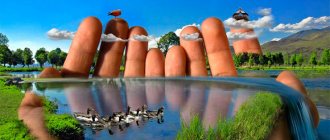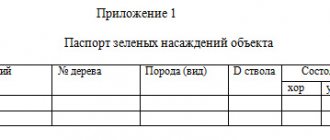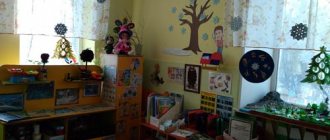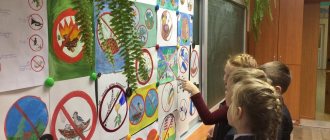From the experience of work “Environmental education of preschool children”
Elena Stolyarova
From the experience of work “Environmental education of preschool children”
MUNICIPAL AUTONOMOUS PRE-SCHOOL EDUCATIONAL INSTITUTION KINDERGARTEN OF GENERAL DEVELOPMENTAL TYPE No. 8 “FAIRY TALE”
From work experience
Topic: “ Environmental education of preschool children ”
Full name: Stolyarova Elena Pavlovna
Place of work : Municipal Autonomous Preschool Educational Institution, general developmental kindergarten No. 8 “FAIRY TALE”
Position: Educator
Date of birth: March 27, 1982
Total work experience: 10 years
Teaching experience: 6 years
Education: higher, Armavir State Pedagogical University.
experience been generalized before : no
Date of entry :
Content
1. Introduction
2. Relevance
3. Conditions for the emergence and development of experience
4. Duration of work on the experiment
5. Means to achieve the goal
6. Motto
7. Goal, objectives
Introduction
Ecology is a science that teaches us to take care of the environment, the Earth. The world is colorful and bright. “The world around us, the Earth is our Green Home”
. Seas and rivers, forests and mountains, villages and cities... There is so much in this wonderful house! And together with us, plants and mushrooms, insects and fish, birds and animals live in it...
The outstanding teacher V. A. Sukhomlinsky attached special importance to the influence of nature on the moral development of a child. In his opinion, nature underlies children's thinking, feelings, and creativity. He noted that nature itself does not educate , but actively influences interaction with it, and in order for a child to learn to understand nature and feel its beauty, this quality must be instilled from early childhood.
The intrinsic value of preschool childhood is obvious : the first seven years in a child’s life are a period of rapid growth and intensive development, the beginning of personality formation. K. D. Ushinsky was in favor of “leading children into nature”
to communicate to them everything accessible and useful for mental and verbal development. Ya. A. Komensky saw in nature a source of knowledge, a means for the development of the mind, feelings and will.
Relevance
The problem of the relationship between man and nature has always existed. But at present, the problem of interaction between man and nature, as well as the interaction of society on the environment, has become very acute and has assumed enormous proportions.
A modern preschool educational institution is designed to educate a generation that has a special vision of the world as an object of constant concern.
Environmental education is the most important task of preschool educational institutions at present. Environmental begin at a young age, because at this time the acquired knowledge can later be transformed into strong beliefs.
Most modern children rarely communicate with nature. Environmental education begins with familiarization with the objects of the immediate environment. that a child encounters every day.
Conditions for the emergence and development of experience
Environmental education is the formation in a person of the ability and desire to act in accordance with the laws of ecology , which he learned during the learning process. Environmental education is the resultant of all aspects of mental , moral, patriotic, aesthetic, physical, and labor education.
Duration of work on the experiment On the topic : “ Environmental education of preschool children ”
have been working in the educational process for one year.
Means of achieving the goal: Raising in children a love for nature and the ability to perceive its beauty .
Motto:
“Take care of this Earth, this water,
I love even a small epic.
Take care of all animals within nature,
Kill all the beasts within you."
The goal of the work is to form in children a holistic view of nature and man’s place in it, a responsible attitude towards the environment, towards their health, and towards the health of others.
I have identified the following tasks:
— To form in preschoolers a conscious attitude towards nature, its phenomena and objects;
— Improve the ability and skills of observing living and inanimate objects of nature;
— To develop environmental thinking and creative imagination in the process of experimental and research activities of children;
— To educate elementary standards of behavior in relation to the natural world and the surrounding world as a whole.
I am a creative, emotional person, I have always paid a lot of attention to this topic - the formation of knowledge about living and inanimate nature, about natural phenomena, as well as the education of moral feelings . At this stage I have studied a lot of literature on environmental education of children :
I took the N program as a basis for my . A. Ryzhova “Our home is nature”
and the technology of Z. F. Aksenova -
“Enter nature as a friend
.
When writing experiences , I follow the following pedagogical principles:
• consistency;
• visibility;
• availability;
• taking into account the age and individual characteristics of children;
• seasonality.
In my opinion, ecology can be passed through all types of activities of a preschooler . Due to this opportunity, work turns out to be both useful and interesting for both me and the preschool children .
The use of fiction in combination with small forms of folklore evokes a range of feelings in children - emotion, admiration, tenderness, delight. They instill in children a belief in the weight and significance of words.
To help children in an entertaining way identify the features of natural phenomena, seasonal changes in nature, determine the qualities of an object, the habits of animals, I use riddles, poems, proverbs, sayings, nursery rhymes. In nursery rhymes, all the phenomena and forces of nature come to life: the sun, rainbow, thunder, rain , wind, seasons live like animate beings. Children seem to come into contact with them themselves.
Reading fairy tales should be one of the obligatory components of environmental education of children , says Doctor of Pedagogical Sciences N.A. Ryzhova, I completely agree with her. Children really like reading fairy tales about animals; they listen carefully and remember them, but find it difficult to tell them themselves. But theater activities, which I like to do with young children, help me cope with this problem. Children like to show fairy tales, to be artists, embarrassment goes away, even the most shy child performs with pleasure. In this type of activity, children’s correct speech is formed, their vocabulary is replenished and activated, and, of course, memory and attention develop. I know very well the individual characteristics of each child, what he is capable of in a given situation, so when assigning roles I approach them with understanding. If a child wants to be someone in a fairy tale, and I know that he may not succeed and he will become upset and withdrawn, then I try to convince him to take another role and at the same time not infringe on his dignity.
An important source of knowledge about nature is observation. One of the goals of my work is to improve children's skills in observing living and inanimate objects of nature. In the process of observation, children learn to peer, admire, rejoice and admire the beauty of nature; they develop observation and curiosity, a kind, caring attitude towards natural objects. Observation makes it possible to introduce children to natural phenomena and the relationship between living and inanimate nature. I organize observations with children when introducing children to plants and animals, the weather, the work of adults in nature, during classes and excursions, on walks, in a corner of nature, etc.
In my work on environmental education I use various traditional and non-traditional forms, methods and techniques, taking into account the age and individual characteristics of children. To expand children's ideas about nature, to deepen children's knowledge, I use ICT. They, due to their clarity, colorfulness and simplicity, allow me to more effectively build the process of learning new concepts for children of generalization and systematization of knowledge.
To successfully implement the assigned tasks, I have developed :
— An experimentation corner has been set up ( experiments , experiments, observations)
— Organized a vegetable garden on the window. Children grow onions, beans, parsley, cucumbers, flowers….
— A card index has been created, including a selection of environmental games , physical education lessons, riddles and poems about nature, presentations, and songs.
— A mini library of children's literature and encyclopedias has been created.
I pay a lot of attention to working with parents . the main goal in working with families is to achieve unity in raising a child . It is necessary that the upbringing of children in preschool educational institutions and in the family be uniform. I always stand by the fact that we have the same goal - to raise purposeful , kind, balanced and loving people. To achieve this goal, I organize environmental holidays for children and parents, exhibitions, training games, and consultations. I try to conduct parent meetings in a very rich and informative way. I select material for information stands and communicate individually. In this way, I try to bring the family and the preschool educational institution closer together.
One of the effective and most interesting means of environmental education for children is games . V. A. Sukhomlinsky spoke about the game like this: “Without play there is and cannot be full-fledged mental development. A game is a huge bright window through which a life-giving stream of ideas and concepts flows into the child’s spiritual world. Play is the spark that ignites the fire of inquisitiveness.”
In my work with children, I attach great importance to gaming technologies.
environmental games primarily for the purpose of clarifying, consolidating, generalizing, and systematizing knowledge. While playing, children better acquire knowledge about objects and natural phenomena, learn to establish relationships between them and the environment, learn about ways of adaptation of living beings to the conditions of their habitats, about the sequential change of seasons and about changes in living and inanimate nature. Great opportunities for developing environmental feelings in relation to the world around us lie, first of all, in didactic games.
Didactic games are a multifaceted and complex phenomenon. This is a method and form of learning, an independent play activity, and a means of comprehensive personality education . I use didactic games not only in children’s free activities, but also include them in classes, targeted walks, as well as in experimental activities of pupils . Games with various natural materials (vegetables, fruits, flowers, stones, seeds, dry fruits, which bring children as close as possible to nature and always arouse keen interest and an active desire to play) are very effective.
Of particular joy and interest to children are outdoor games of a natural history nature, which are associated with imitation of the habits of animals and their way of life: “Little Frogs and Heron”
,
“Mice and the Cat”
, some games reflect the phenomena of inanimate nature:
“Droplets”
,
“Sun and Rain”
. The joy gained in the game helps to deepen children's interest in nature and the development of physical qualities
Word games: “Find out by description”
;
"Good bad"
;
“What’s extra?”
;
"Recognize by voice"
;
“Who is screaming?”
;
“Who came to us?”
develop children's attention, imagination, and increase knowledge about the world around them.
With the help of toys and pictures, I introduce children to domestic and wild animals, and cultivate interest in them and their babies. For a deeper study of this topic, I made mini-models of “Animal Farm”
and
“Forest Glade”
, here children see the difference in the lives of domestic and wild animals.
In my work I use experimental research activities . Children are born explorers. And this is confirmed by their curiosity, constant desire to experiment, and desire to independently find a solution to a problem situation. My task is not to suppress this activity, but, on the contrary, to actively encourage it.
experimental research activities in games and activities; it can be associated with children’s work in a corner of nature and in the garden.
First of all, a corner of nature where indoor plants are kept helps to introduce children to nature and cultivate Children see plants in this corner of nature every day; under my leadership, children systematically observe and care for them. Working in a corner of nature has great educational value . Children develop a caring, caring attitude towards nature and develop a responsible attitude towards their responsibilities. In the process of care, children gain an understanding of the diversity of the plant world, how plants grow and develop, and what conditions need to be created for them. She also created a corner of nature, where there are natural materials, visual aids, educational games, card indexes of riddles about animals and plants, observations in nature, artistic expression, physical education lessons, finger games, a nature calendar (children regularly record the weather and the state of wildlife by inserting pictures with natural phenomena observed on the street, “garden on the window”
.
The most effective way to implement the tasks of environmental education is to organize project activities. I believe that project activities (as a way to implement a student-centered approach in education)
is a unique means of ensuring cooperation and co-creation between children and adults.
A project, in translation, is a plan, a plan, a “serious game”
where the results are significant for both children and adults.
Design is focused on unique child-adult
, which are built on participation in activities - this is communication on equal terms, where no one has the privilege to indicate, control, evaluate.
I have developed environmental projects :
“Vitamins grow in the garden”
Target:
-Expand and generalize children’s knowledge about vegetables through different types of activities.
-Explain that vegetables contain vitamins necessary for our health.
"Wild and Domestic Animals"
Tasks:
-Create conditions for the formation of cognitive interest in children. -Introduce children to vitamins.
-Teach to distinguish vegetables by color, shape, size.
-Consolidate acquired knowledge.
-Develop in children the desire to reflect their ideas in productive activities (drawing, modeling)
.
-Broaden horizons, develop observation, curiosity, coherent speech, enrich children’s vocabulary.
-To instill in children a desire to participate in work activities (planting onions)
;
cultivate a culture of nutrition , understand that behind every vegetable there is a certain benefit.
"Wild and Domestic Animals"
Objective of the project:
• Develop sustainable cognitive interest
• treat wild and domestic animals as living beings.
•Form ideas about animals: structure, characteristic features - size, lifestyle features (how they move, what they eat, what sounds they make)
.
• Promote love and care for pets, the emergence of curiosity.
• Create conditions in the group to expand the understanding of animals.
• Involve parents in closer cooperation in project activities.
•Tasks:
• To form children’s initial ideas about wild and domestic animals, expanding children’s horizons.
• -Develop children’s ability to answer the teacher’s .
• -Form a holistic picture of the world, including primary value ideas about animals, through reading children's fiction.
• -Develop aesthetic perception .
• -Develop fine motor skills of the hands.
• -Develop the ability to perform imitative movements, imitate the movements of animals.
• -Follow basic rules of behavior with animals.
• -Accumulation and enrichment of children's motor experience .
• -Introduce children to music.
CONCLUSION:
• The experience of my work has shown that purposeful, systematic work on environmental education of preschool children , in an interesting, entertaining form, helps children see all the beauty of nature, reveal all its secrets and laws, instill in children kindness , a responsible attitude towards the world around them, people who live nearby.
• Childhood years are the most important and how they will pass depends on parents and us, teachers. It is very important to reveal to parents the developmental aspects of each child in a timely manner and recommend appropriate techniques.
Expected results.
• • Clarify, systematize and expand children's knowledge about plants, animals and natural phenomena.
• • Develop a conscious understanding of the relationships in nature.
• • Develop an emotionally friendly attitude towards living objects.
• • Develop skills and abilities to properly interact with nature.
• • Promote the need for environmental education of preschool children among parents .
Planning work for the future .
• 1. Continue searching for new sources and new technologies for environmental education .
• 2. Hold an open event with the active participation of parents.
• 3. Develop long-term planning for environmental education in the senior group .
• 4. Development and implementation of a long-term project.
MAGAZINE Preschooler.RF
From the experience of working on ecology on the topic “Education of environmental culture in preschool children in the context of the Federal State Educational Standard for Education”The main goal of environmental education is the formation of the child’s correct attitude towards the nature around him, towards himself as a part of nature. Love for nature, a conscious, careful and interested attitude towards it, must be cultivated from early childhood, therefore I pay great attention to environmental education.
I have identified the following tasks:
- To form in preschoolers a conscious attitude towards nature, its phenomena and objects
- Improve the skills and abilities of observing living and inanimate objects of nature
- To develop ecological thinking, creative imagination and speech in the process of experimental and research activities of children
- Develop basic standards of behavior in relation to the natural world and the environment in general.
In my opinion, ecology can be integrated into all types of children's activities. Thanks to this opportunity, my work turns out to be both useful and interesting for both me and the children.
To successfully implement the assigned tasks, I have developed:
- A set of educational activities using ICT.
- A long-term plan for educational activities with preschool children has been developed.
- The experimentation center has been improved (experiments, experiments, observations), a natural corner with various plants, a vegetable garden has been created on the windowsill where children grow onions, garlic, beans, parsley, dill, oak trees, cucumbers, and flowers.
- The card index has been replenished, including a selection of presentations, environmental games, physical education lessons, riddles, poems and songs about nature.
- The children's mini-library with works of children's literature and various encyclopedias is constantly updated.
In my work on environmental education I use various traditional and non-traditional forms, methods and techniques, taking into account the age and individual characteristics of children.
The use of fiction in combination with small forms of folklore evokes a range of feelings in children - emotion, admiration, tenderness, delight. They instill in children a belief in the weight and significance of words.
To help children in an entertaining way identify the features of natural phenomena, seasonal changes in nature, determine the qualities of an object, the habits of animals, I use riddles, poems, proverbs, sayings, and nursery rhymes.
In nursery rhymes, all the phenomena and forces of nature come to life: the sun, rainbow, thunder, rain, wind, seasons live as animated beings. Children seem to come into contact with them themselves: they ask the sun for warmth and affection.
An important source of knowledge about nature is observation. One of the tasks of my work is to improve children’s skills in observing living and inanimate objects of nature. In the process of observation, children learn to peer, admire, rejoice and admire the beauty of nature; they develop observation and curiosity, a kind, caring attitude towards natural objects. Observation makes it possible to introduce children to natural phenomena and the relationship between living and inanimate nature. I organize observations with children when introducing children to plants and animals, the weather, the work of adults in nature, during classes and excursions, on walks, in a corner of nature, etc. Developed cycles of observations of living natural objects.
First of all, a corner of nature where indoor plants are kept helps to introduce children to nature and cultivate a love for it. Children see plants in this corner of nature every day; under my leadership, children systematically observe and care for them. Working in a corner of nature has great educational value. Children develop a caring, caring attitude towards nature and develop a responsible attitude towards their responsibilities. In the process of care, children gain an understanding of the diversity of the plant world, how plants grow and develop, and what conditions need to be created for them. Also in the corner of nature there is natural material, visual aids, educational games, card indexes of riddles about animals and plants, observations in nature, literary expression, physical education lessons, finger games, a nature calendar (children regularly record the weather and the state of wildlife that they observed on the street ). Various models are substitutes for real objects (globe, weather calendar, drawings-models of plants, animals and other natural objects, natural phenomena).
One of the effective and most interesting means of environmental education for children is gaming technologies, which include various types of games. I use environmental games primarily for the purpose of clarifying, consolidating, generalizing, and systematizing knowledge. While playing, children better acquire knowledge about objects and natural phenomena, learn to establish relationships between them and the environment, learn about ways of adaptation of living beings to the conditions of their habitats, about the sequential change of seasons and about changes in living and inanimate nature. Great opportunities for developing environmental feelings in relation to the world around us lie, first of all, in didactic games.
Didactic games are a multifaceted and complex phenomenon. This is a method and form of education, an independent play activity, and a means of comprehensive personality education.
I use didactic games not only in children’s free activities, but also include them in classes, targeted walks, as well as in experimental activities. Games with various natural materials (vegetables, fruits, flowers, stones, seeds, dry fruits) are very effective, which bring children as close as possible to nature, and always arouse keen interest and an active desire in children to play. For example: “Children on the branches” , “Tops and roots” , “Which tree is the leaf from” , “Wonderful bag” , “Guess what you ate” , “Find the same plant in the bouquet” , etc. Special joy and Children are interested in outdoor games of a natural history nature, which are associated with imitation of the habits of animals, their way of life: “Little Frogs and a Heron” , “Mice and a Cat” , some games reflect the phenomena of inanimate nature: “Droplets” , “Sun and Rain” , "Cheerful breeze" . The joy gained in the game helps to deepen children's interest in nature and the development of physical qualities.
In my work I use experimental research activities. Children are born explorers. And this is confirmed by their curiosity, constant desire to experiment, and desire to independently find a solution to a problem situation. My task is not to suppress this activity, but, on the contrary, to actively encourage it. I include experimental research activities in games and activities; it can be associated with children’s work in a corner of nature and in the garden.
The most effective way to implement the tasks of environmental education is to organize project activities. I have developed environmental projects “Young Nature Defenders” , “Let’s Help the Birds in Winter” , “Amazing Insects” , “Mushrooms - Mushrooms” , “Love and Know Your Land” , etc.
The general objectives of these projects were:
- to form in children and parents a sense of belonging to all living things, a humane attitude towards the environment and a desire to show concern for the conservation of nature.
- create an environmentally friendly environment on the territory of the preschool educational institution for the implementation of the priority direction;
- develop the cognitive skills of children and parents while mastering research methods of understanding nature;
organize practical environmental activities of children and parents;
- implement one of the forms of work with parents of design and research activities “Ecological Mail” .
- develop mutual understanding and mutual assistance between children, teachers, parents, the need for constant self-development of environmental culture;
- develop initial geographical concepts, familiarity with the simplest methods of orienteering;
- to educate children to have an attentive, reasonable, and caring attitude towards the natural environment.
The novelty of environmental projects lies in the use of information and computer technologies. The main fact that ensures the effectiveness of the educational process is the personal involvement of children and parents. By using new, exciting technologies, this inclusion can be achieved. Projects allow children and parents to participate in environmental actions ( “Clean Morning” , “Feed the Birds in Winter” , “So that the Trees Grow Big” , etc.). Working on environmental projects is a unique opportunity for children and parents to express themselves and benefit the surrounding nature of their native land.
Expected project results:
- creation of an environmentally friendly environment on the territory of the preschool educational institution
- increasing the level of knowledge on ecology in children
- improving the level of knowledge and environmental competence of parents on the topic of the project.
I pay a lot of attention to working with parents. I consider the main goal in interaction with the family to be achieving unity in raising a child. To achieve this goal, I organize environmental holidays for children and parents, outdoor entertainment events, exhibitions, performances, excursions, training games, tea parties, consultations, workshops, master classes. I select material for information stands and communicate individually.
All the work contributed to the unity of families and teaching staff, instilling in children a love for their home, for nature in general, the formation of a more holistic perception of the world, and the development of an environmental culture among preschoolers.
Analyzing the results of the work, I came to the conclusion that the formation of knowledge and skills in environmental education in children is most productive if it occurs in the context of practical, project and play activities, when conditions are created under which the knowledge acquired earlier becomes necessary for them, as it helps solve a practical problem and therefore are learned easier and faster.
Children have become emotionally active in the classroom, they have formed their own style of behavior and activity in nature, the level of their environmental education has significantly increased, which is expressed, first of all, in a qualitatively new attitude towards nature, participation in educational games, exhibitions, and competitions. Students from my group are regular participants and winners of competitions at various levels.
The experience of my work has shown that purposeful, systematic work on environmental education of preschool children, in an interesting, entertaining form, helps children see all the beauty of nature, reveal all its secrets and laws, instill in children kindness, a responsible attitude towards the world around them, the people who live near.
| Next > |








